You could say that charlottes are part of the trifle family of desserts in that they are no-bake (except for the cake, which is used to cover the outside) and made in a glass dish or mold. They originated in Britain in the 1700s and supposedly were named after Queen Charlotte, wife of King George III, who reigned during the American Revolution and who steals the show in the Broadway musical “Hamilton.”
The two most well-known types of charlotte are charlotte russe and charlotte royale. While the original charlotte was probably a simple affair made with stewed apples covered with stale bread or breadcrumbs, charlotte russe has a Bavarian cream filling instead of fruit and is surrounded by ladyfingers. It is said to have been invented by French Chef Marie-Antoine Carême, who worked for a time as personal chef to the heir to the British throne, George IV, before taking a position with Tsar Alexander of Russia, in which case it could have been named for George IV’s only child, Princess Charlotte, or for Alexander’s sister-in-law, Charlotte of Prussia.
Charlotte royale, on the other hand, has a much murkier history. It most likely came along after charlotte russe and may have also been invented by Chef Carême. It is similar to a charlotte russe except instead of ladyfingers it is lined with Swiss roll slices.

Mary Berry set this challenge for the bakers, calling for a “perfect Swiss roll” very tightly packed into the bowl so that none of the bavarois (Bavarian cream) peaks through. Bavarois, which may also be an invention of the famous Chef Carême, consists of a thin custard, or crème anglaise, that is thickened with gelatin before folding in whipped cream. It may also be flavored with a fruit puree, as in Mary Berry’s recipe here.
This technical challenge was split into two days. The bakers were given two hours on the first day, and then they came back to put the finishing touches on their bake the next morning. This is so the bavarois could firm up in the fridge overnight.
There are a lot of steps to this dessert, but it’s not that difficult. It helps if you know what you’re doing, though, and having never made Bavarian cream before, I was somewhat flying by the seat of my pants.

The first step is to make jam for the Swiss roll. When I first started watching “The Great British Baking Show,” I was surprised that they always made their jam from scratch. When I was growing up, jam-making was always a day-long affair, so if you needed jam for a recipe, you either bought it ready-made or you pulled a jar off the pantry shelf. But watching the bakers in the Great White Tent, I realized that making a small batch of soft-set jam doesn’t entail a lot of work and uses just three simple ingredients: fruit, sugar and a little bit of butter. After boiling the fruit and sugar together for a few minutes, remove from heat, stir in the butter until melted and set aside to cool. Et voilà!
The sponge that’s used for a Swiss roll is a fatless sponge, as Kimberley explains in this episode, because adding fat would make a “shorter” texture, which would crumble too much to make a good roll. So again, three simple ingredients—this time eggs, sugar and flour—are combined in just the right way and then baked in two 9-by-13-inch pans to create two thin, very light layers.
While still warm, the cakes are turned out of the pans, rolled up in sugar-sprinkled parchment, and allowed to cool before unrolling and spreading them with jam. Rolling them while still warm prevents cracking and, as Kimberley also explains, gives them a bit of “muscle memory” so they hold their shape better.

Trim the cake while still warm. 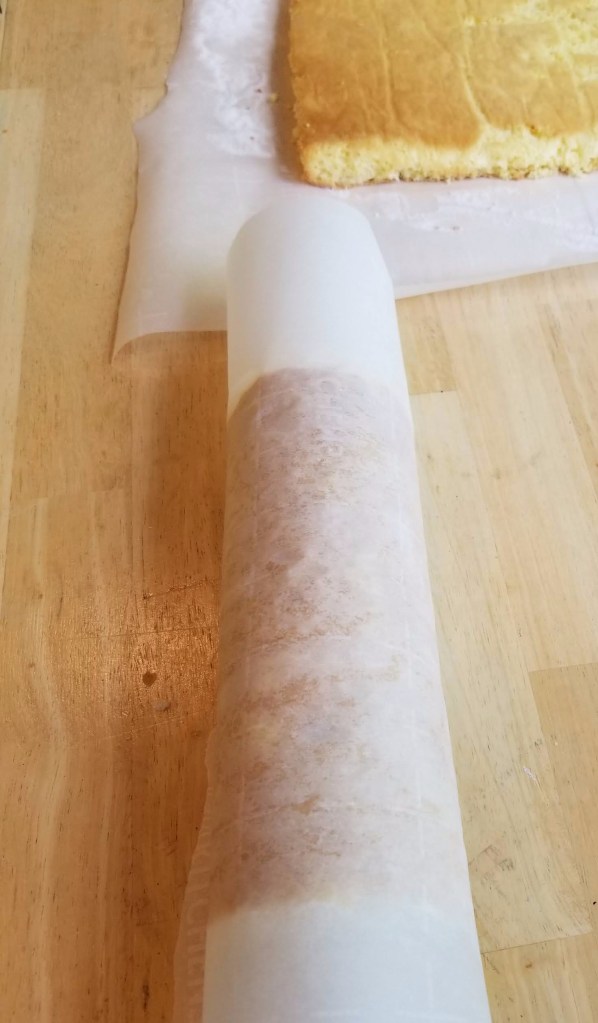
Roll up in parchment to cool. 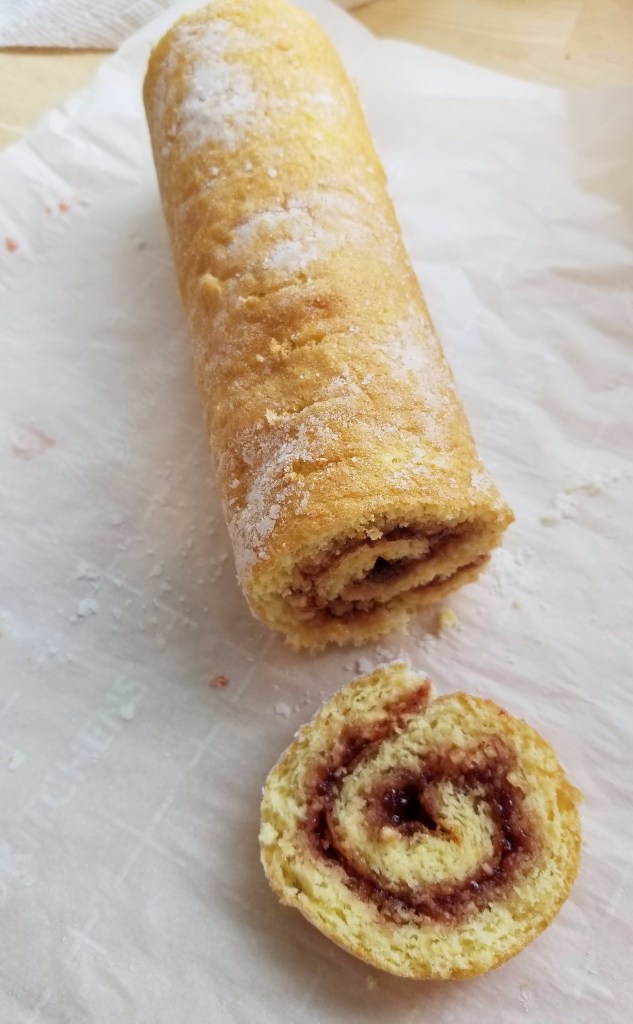
Spread with jam, roll and slice.
While my cakes were cooling, I started making the bavarois. This was my first time using sheet gelatin, and I didn’t want to let it soak for too long, so I made my raspberry puree first, then began soaking the gelatin while I started my custard. After soaking the gelatin sheets in cold water for 5-10 minutes to soften them, you’re supposed to gently squeeze the excess water out. Never having done this before, I wasn’t sure how “gently” to squeeze, so I went with my intuition. After adding the softened gelatin to the hot custard, I put the whole thing back on the stove to thicken slowly. When it was thick enough to coat the back of a spoon and I could draw a line through it with my finger, I took it off the heat. After I folded in the raspberry puree, I was afraid I might have overcooked the custard because it looked a little grainy, like it might have “split,” so I poured it through a sieve to remove any lumps.

Here’s what the gelatin sheets look like before soaking. 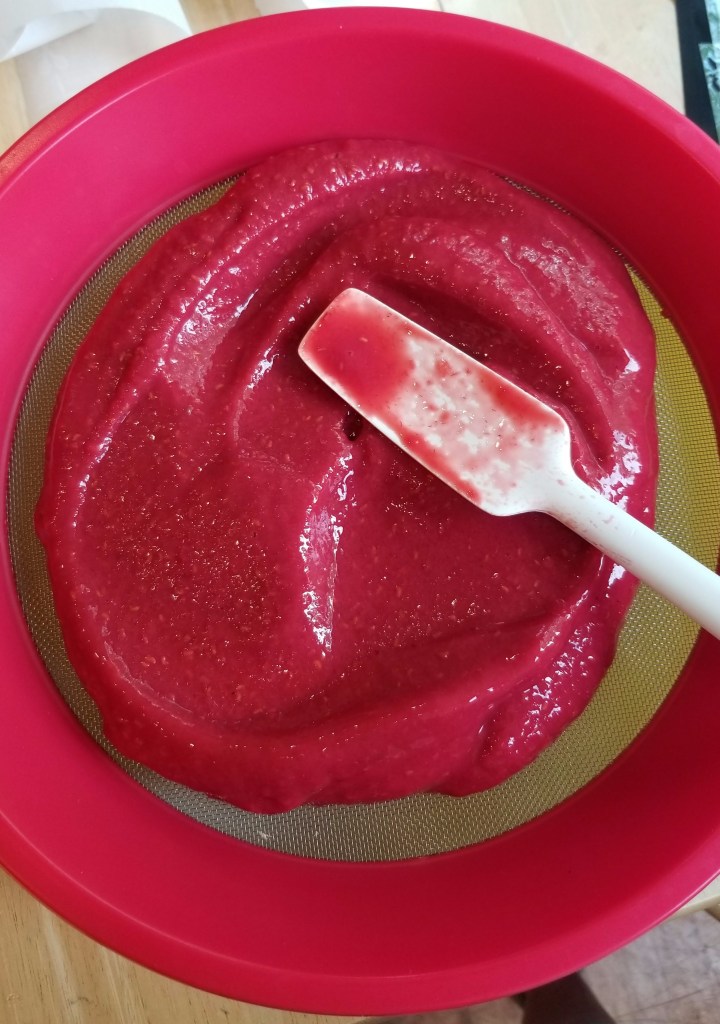
I love that raspberry puree (sung to the tune of Prince’s “Raspberry Beret”)! 
Allow the custard to cool slightly before folding in the puree.
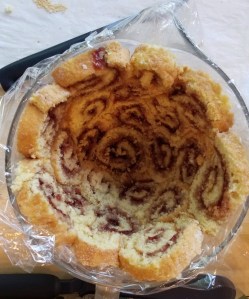
Once the bavarois was chilling, I unrolled and spread my Swiss rolls with jam, then cut them into 5/8-inch slices. After lining a 2-quart bowl with plastic wrap, I placed the Swiss roll slices all around the inside of the bowl, pressing them tightly against each other so I couldn’t see any light coming through. I had three slices left over to put on top of the filling, which would become the base of the charlotte.
When the bavarois was set to the consistency of thick heavy cream, I whipped the cream and folded it into the mixture. Then I folded in the whole raspberries and strawberries and ladled it into the Swiss-roll-lined bowl. (There was enough left over to fill four parfait glasses with Bavarian cream and fruit for a delicious, light dessert!) After placing the three remaining Swiss roll slices on top of the cream, I covered it and popped it into the fridge for the night.

In the morning, I turned out my charlotte onto a serving plate and made the arrowroot glaze. This was the weirdest part of the bake, as the glaze is very viscous, almost mucus-y. It had to be spread quickly before it turned into a jelly-like mass. Then I decorated the charlotte with whipped cream and the remaining strawberries.
It certainly looked like it was supposed to. It would definitely make a showstopping party dessert. But did the filling set properly? Holding my breath, I cut into it. Sure enough, the bavarois held its shape, and a beautiful pink wedge slid onto my plate. I took a bite. Mmmm! Nice and light, fruity and not overly sweet. Perfect for a summer picnic or any special occasion!
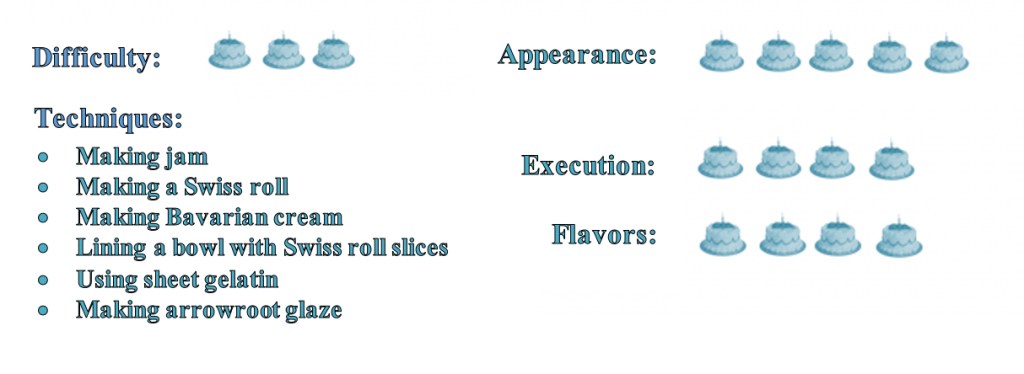

Here is a link to Mary Berry’s recipe, but I have adapted it for American baker’s below.
Mary Berry’s Charlotte Royale
Adapted for American bakers
For the jam:
For the Swiss rolls:
For the bavarois:
- 1 lb. fresh or frozen raspberries
- 2 T. raspberry liqueur
- 9 leaves gelatin*
- 2½ c. whole milk
- 8 large egg yolks
- ½ c. superfine (baker’s) sugar
- 2 c. heavy whipping cream
- 4 oz. fresh, whole raspberries
- 3½ oz. strawberries, halved or quartered
To decorate:
- 1/3 c. superfine (baker’s) sugar
- ½ c. + 2 T. cold water, divided
- 1 T. arrowroot
- ½ c. + 2 T. heavy whipping cream
- 3 T. powdered sugar
- 10 medium strawberries
Directions
- To make the jam, put the prepared strawberries into a medium-sized saucepan with the sugar and cook over low heat, stirring occasionally, until the sugar has dissolved. Bring the mixture to a boil and boil vigorously for about 4 minutes until the temperature reaches 219°F on a candy thermometer, or setting point. Remove from heat and add the butter, stirring until melted. (NOTE: If you still have large chunks of berries, you can use an immersion blender to make a smoother jam.) Transfer to a heatproof bowl and leave to cool and set.
- Grease and line two 13-by-9-inch baking pans with parchment paper. Preheat the oven to 425°F. To make the Swiss rolls, put the eggs and sugar into a large mixer bowl and, using an electric mixer fitted with the whisk attachment, whisk until the mixture is light and frothy and makes a ribbon trail on itself when the whisk is lifted out of the bowl. Sift the flour over the mixture and carefully fold it in.
- Divide the mixture evenly between the two prepared pans. Give them a gentle shake to level the mixture, gently pushing the mixture into the corners if necessary. Place in the heated oven and bake for 10–12 minutes, until the sponges are golden and starting to shrink from the sides of the pan.
- While the cakes are baking, lay two sheets of parchment paper (a little larger than each pan) on the work surface and sprinkle them with baker’s sugar. As soon as the cakes are done, turn them out onto the sugared paper and carefully peel off the lining paper. Trim the edges of the cakes with a serrated knife (making them easier to roll neatly), and score each cake across one of its short edges, ¾ inch from the edge (being careful not to cut all the way through). Starting at the scored end, roll the cakes up with the parchment and leave to cool slightly before filling. Once the cakes are cooled, unroll and spread them with the strawberry jam, then roll up each cake firmly from the scored end (leaving the parchment out this time) and put in refrigerator until needed.
- To make the bavarois, puree the one pound of raspberries in a food processor or blender. Pour into a sieve set over a mixing bowl and press the puree through the sieve to remove the seeds. Stir the liqueur into the puree and set the misture aside until needed.
- Soak the gelatin leaves in a bowl of cold water for about 10 minutes until softened.
- Meanwhile, pour the milk into a saucepan and heat to just under the boiling point. While the milk is heating, use an electric mixer to whisk the egg yolks with the sugar in a heatproof bowl until pale and creamy. Continue whisking while pouring the hot milk into the yolk mixture in a slow steady stream.
- Drain the gelatin and gently squeeze out the excess water. Then add the softened gelatin to the milk mixture and whisk until melted. Pour the mixture back into the pan and cook gently, stirring constantly, until thickened enough to coat the back of the spoon and you can draw a line through it with your finger. (Don’t let the custard come to a boil or it will split.) Pour the custard into a clean, heatproof bowl and allow to cool slightly before folding in the raspberry puree. Then chill the mixture for at least an hour or until it has set to the consistency of thick heavy cream.
- Line the base of a 7- or 8-cup round bowl with plastic wrap. Cut the Swiss rolls into 5/8-inch-thick slices, and line the base and sides of the bowl with the slices, packing them close together so the filling will not be able to seep through. Reserve enough slices to cover the top (which will become the base of the charlotte).
- Whip the 2 cups of cream for the bavarois until stiff peaks form. Gently fold the whipped cream into the chilled bavarois mixture. Fold in the remaining 4 ounces of raspberries and 3½ ounces of strawberries, then spoon the mixture into the lined bowl. (NOTE: You will probably have leftover bavarois. I recommend spooning it into parfait glasses with any leftover berries you might have. Chill in the fridge until set. It makes a wonderful dessert on its own!) Lay the reserved slices of Swiss roll on top of the bavarois, cover the bowl with plastic wrap, and chill overnight until set and firm.
- To finish, turn the charlotte out onto a serving plate and peel off all the plastic wrap. Put the 1/3 cup of sugar into a small saucepan with the ½ cup of water and bring to a boil, stirring to dissolve the sugar. Mix the arrowroot with the 2 tablespoons water until smooth, then stir the mixture into the sugar syrup to thicken it. Bring it back to a boil, stirring constantly, and then immediately remove from heat. Let cool slightly before spooning the glaze over the charlotte to give an even, shiny coat. Leave to set for about 5 minutes, then clean up the serving plate with a paper towel to remove any excess glaze.
- Whip the remaining cream with the powdered sugar to stiff-peak stage. Spoon it into a piping bag fitted with a star tip and pipe a continuous design of scallops around the base of the charlotte. Decorate with strawberries cut into fan shapes. Serve immediately or keep in refrigerator until ready to serve.
*NOTE: When purchasing sheet gelatin, you’ll find it comes in different strengths or “blooms” ranked by grade: bronze, silver, gold and platinum. Don’t worry too much about what grade you buy, because the size of the sheets are adjusted accordingly, so the stronger grades will come in slightly smaller sheets than the weaker grades. Sheet-for-sheet, each should have the same setting properties.
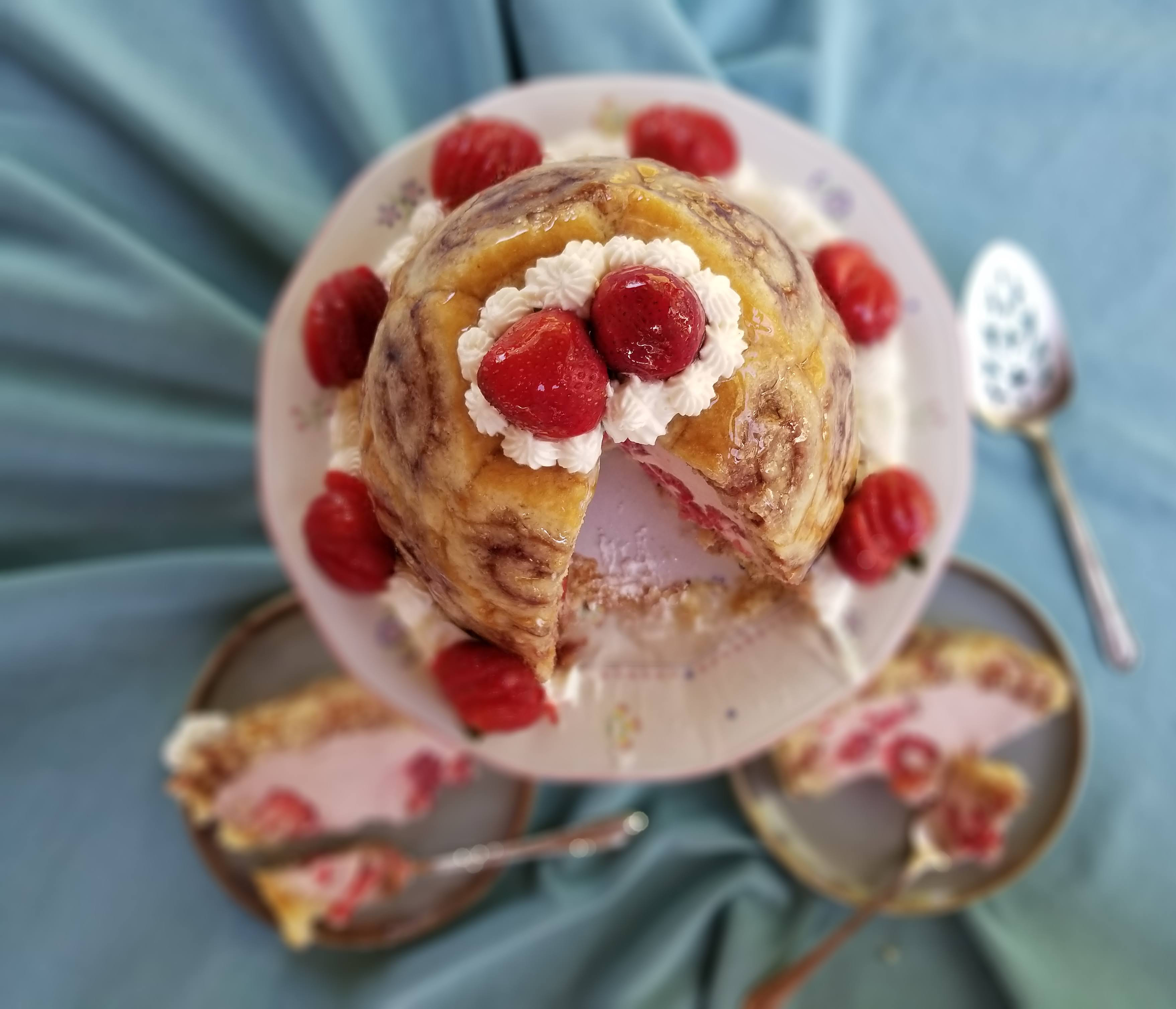
Next week: Opera Cake
Discover more from Here's the Dish
Subscribe to get the latest posts sent to your email.


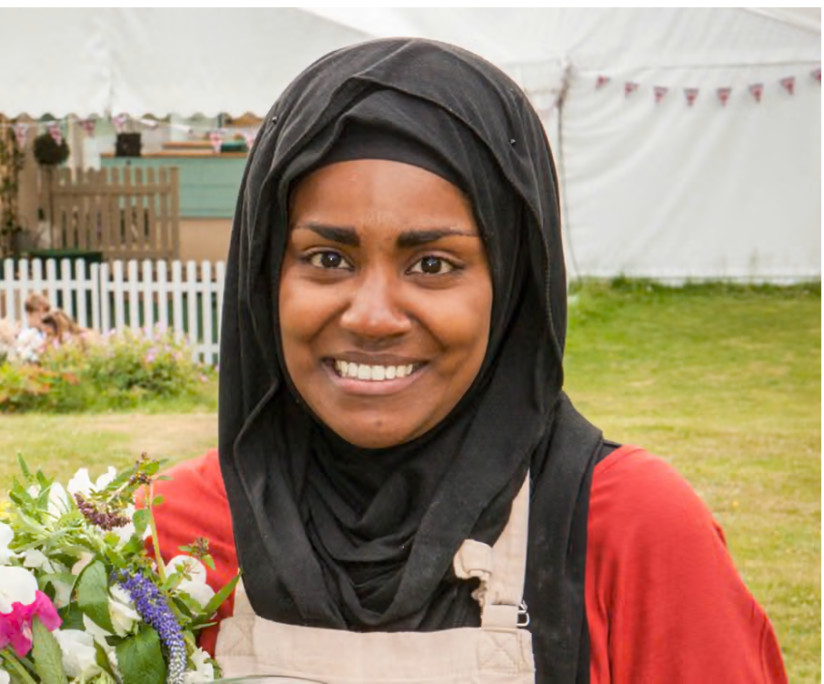
1 thought on “Charlotte Royale”